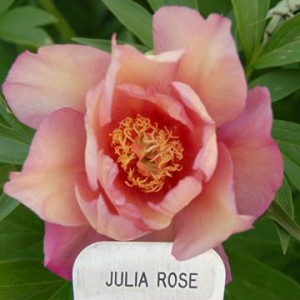 Peonies have been referred to as the ‘Queen of the Garden’ and they truly deserve this title. They are available as single, semi-double and huge fully double shapes in numerous colours including white, yellow, pink, red and very dark burgundy.
Peonies have been referred to as the ‘Queen of the Garden’ and they truly deserve this title. They are available as single, semi-double and huge fully double shapes in numerous colours including white, yellow, pink, red and very dark burgundy.
There are in excess of five thousand varieties of the common garden or herbaceous peony. However, there are also numerous tree peonies which have woody stems above ground and in recent years, intersectional or Itoh peonies have become available. These are produced by crossing tree and herbaceous peonies. The intersectional peonies have the growth habits of the herbaceous peonies but the foliage and flower of the tree peony.
Peonies are an amazingly versatile perennial. They are long-lived, often fifty years or more without being moved; very drought tolerant and make excellent cut flowers, as well as outstanding landscape plants. Also they are deer and rabbit resistant. By careful selection, the bloom period last six weeks or more. From spring’s first red shoots to the rich green of summer and then the golden and bronze tones of autumn, peonies provide three seasons of attractive foliage in the garden.
Peonies are divided in the fall starting about mid September because of their growth pattern. The peony root is a large tuber or storage root but in late autumn, fine fibrous feeder roots and growth buds begin to develop. The plants go dormant during the winter. With the warmer spring weather, the buds begin to elongate while the fibrous roots expand further to absorb moisture and nutrients. If a peony is stored bare-root in cold storage or dug in the spring, the fibrous roots will not develop well and plant growth will suffer. Although the plant may recover eventually, it could be many seasons before it will flower.
In early September, cut the foliage off. Growers of large numbers of peonies are advised to garbage or burn these leaves to help eliminate any chance of disease. However, most gardeners can compost the leaves provided they appear healthy and disease free.
If the ground is dry, water the plant the day before you are ready to divide. Using a strong spade, dig deeply around the plant on all sides and lift the plant with as much of the root system as possible, being careful not to damage the crown. Wash the soil from the roots with a strong spray of water and place the root in a shady spot for a few hours. The root will be less brittle and easier to cut. Examine the root. You will see three parts: the eyes or buds of next year’s growth, the crown and the roots. If the roots are very long, trim them to between six to eight inches.
Any division with one eye will grow but it is recommended to have at least three to five eyes per division, so the plant will mature and flower sooner, possibly the first season. Plan your cuts and with a clean, strong knife cut through the root away from yourself. Sometimes on large strong roots, you may have to pry or pull the roots apart and then trim off jagged edges. If some of the large growth buds become damaged, the smaller secondary ones will enlarge and grow. The roots may be stored for several days in bags of peat moss in a cool place.
Peonies need sunny, well drained conditions and since they will not be moved for many years, the garden should be well prepared. Dig a large hole and mix in slow release fertilizer such as bone meal or compost. Never use fresh manure or let any fertilizer come in direct contact with the crown. Plant the peony root with the highest eyes on the crown no more than two inches below the soil surface and firm the soil. It is often recommended that you mulch the plants for the first winter.
Our personal experience dividing peonies was greatly increased in the autumn of 2004 when we relocated the ‘Gilbert collection’ of peonies from the Waterloo area to our property just north of Peterborough, Ontario. Two truck loads of roots were dug, labelled, sorted and divided. We planted nine hundred plants and after planting more each fall, we now have well over six hundred varieties of species, tree, herbaceous and Itoh peonies (4500 plants) on display.
Hazel Cook
Blossom Hill Nursery
www.blossomhillnursery.com
December 2013
